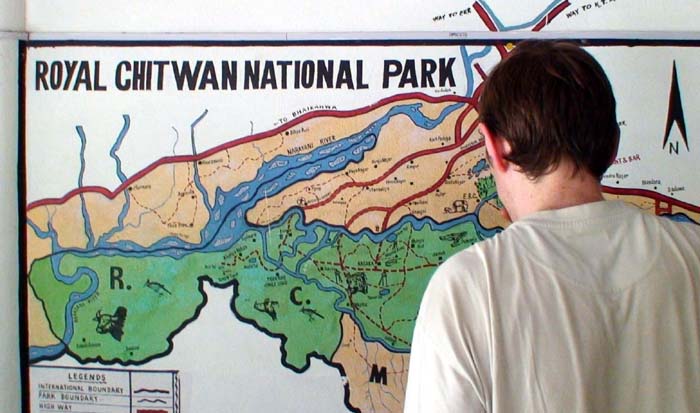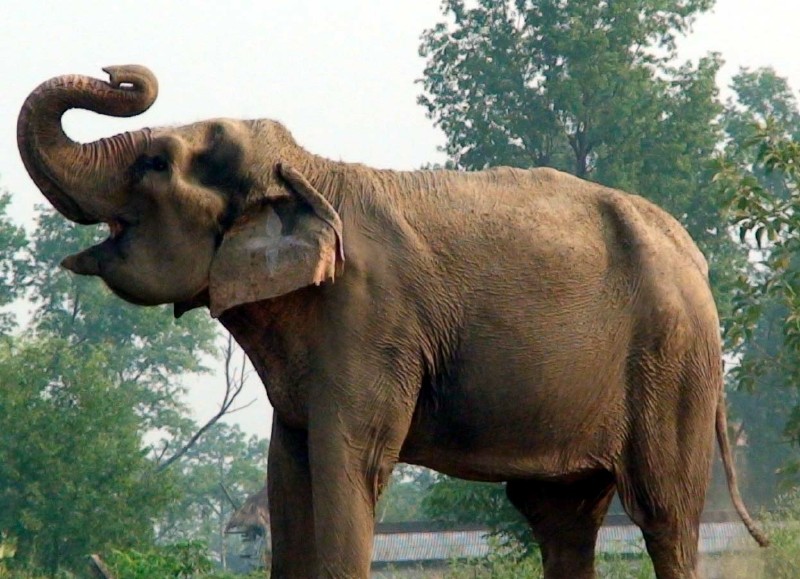This is a quick post about how to do a Chitwan National Park package (all inclusive safari type) for cheap. I provide details that include maps, costs, logistical requirements and facts as well as links to additional details, photos and videos. This is a self-guided adventure on a shoestring. Follow the links to dig deeper into the adventure.
![]()
Total Cost Range of this Activity is: $
Cost Details:
| 3day, 2 night package, with food, transport & lodging Extra drinks, munchies, etc |
$90 $15 |
| Total | $105 |
2008 prices
Animals, Food, & Fun: Chitwan the Package

The Royal Chitwan National Park is a sub-tropical-jungle type of park with a Nepali twist. It contains a host of cheap to expensive guesthouses that provide a plethora of distractions (both nature and comfort oriented) and is considered a must for visitors to Nepal.  I had resisted this ‘Disneyland’ in a jungle on my prior visits to Nepal, but this time I gave in to popular demand and decided to play the tourist. I started by visiting a local travel agency (see below for details) to get package details and pricing. I then put the word out among the drinking/trekking friends that I had made at the Kathmandu Guest House. I drew a line in the sand and told everyone that I was leaving on the following Monday morning and if they wanted to join me (and be filmed) they had to pony up with a $90 contribution.
I had resisted this ‘Disneyland’ in a jungle on my prior visits to Nepal, but this time I gave in to popular demand and decided to play the tourist. I started by visiting a local travel agency (see below for details) to get package details and pricing. I then put the word out among the drinking/trekking friends that I had made at the Kathmandu Guest House. I drew a line in the sand and told everyone that I was leaving on the following Monday morning and if they wanted to join me (and be filmed) they had to pony up with a $90 contribution.
On Monday morning four brave souls met me in front of the guesthouse with hung over expressions. The group consisted of John, Andy, Kat, and Larissa. I now had my principals (victims) and we were in need of a few days away from Kathmandu. We walked to the non-bus park on the Lazimpat (south of the old US embassy) to find our local bus.
In terms of local buses, the bus was quite reasonable. We settled into our tight and uncomfortable seats at 7 am as the bus pulled into bumper-to-bumper morning traffic. It didn’t matter much to us since we were all in very poor shape and fell in and out of sleep for the next few hours of the bumpy, swaying, grinding journey.
Click to watch Video
We stopped for breakfast around 11 am. The stop provided much needed recovery food and leg stretching. We then sweltered in the humid air as the bus continued on its way south, along the river, and down into the Tari hot lands.
We picked up the usual complement of salesmen near the end of the bus journey. They aggressively pitched their accommodation and provided entertainment for those of us who were ignored because we had pre-booked a package.
At the dirt bus park more touts who offered rides and accommodation aggressively once again. We climbed into a jeep provided by the Hotel River View (our destination) and bounced our way to the promise of a cool room.
At the hotel our host confirmed our itinerary and sorted us into boy and girl rooms. We literally raced to our rooms to enjoyed the warm showers (cold water that only got so cold). We then enjoyed a full lunch followed by a long nap.
We started the tourist activities late in the afternoon with a jeep ride to a local village where our guide walked us thru the basics of primitive life in a Tari village. We then rode to the local elephant breeding grounds, where we got to see elephants chained to posts as the sun set. I enjoyed watching the local villagers crossing the river with their herds of water buffalo more than the elephants, but to each his own.
Photos
We then returned to the hotel for another large meal that pretty much finished us off for the day. We had the option to visit the local village cultural show, but it was simply much too humid to do more on that day, so we sat on lawn chairs and slapped at mosquitoes until, at 8 pm, at which time we all agreed to call it a day.
We were up early the next morning (except the girls) to start our canoe ride up the river. The trip was simple, short, and sweet. We then got out on the opposite bank and snuck up on a group of rhinos in a mud pond. The male didn’t look to friendly so we quietly departed for our walk thru the jungle.
By mid-day we were happy to approach the river again and cross back to our hotel for another large and sleepy lunch. However, this time we opted to attend the elephant bathing rather than nap immediately. This activity simply requires you to pick a waiting elephant, climb aboard, get soaked with elephant snot and river water, and then get tossed off by the wiggling elephant. After one such round I opted to stay off and swim in the cool river.
After the ‘elephant bath’ and required 100 Rs tip we all sat under an umbrella and relaxed in the humid shade. I then retired to the hot room for a short nap before the elephant jungle ride.
The elephant jungle ride is like any circus elephant ride, but hotter, stickier, and less comfortable. My four victims were packed onto an elephant, while I got to share mine with only one person. We then set out into the hot jungle and were quickly covered in spider webs, sticky tree stuff, and more elephant snot. Why do elephants have to blow their noses with the trunk pointing back over their shoulders? Is it revenge?
We rode around in an enclosed jungle compound and crossed a river for a few hours until we had seen the requisite rhinos. We then headed back to the un-loading area along the village dirt road. Everyone seemed happy to get off the uncomfortable elephants and dash back to the hotel to shower off the jungle detritus.
After dinner we opted to visit the village and attend the cultural dance show, at least I did. The crew lasted about 10 minutes in the steaming cultural building and then opted to visit a local bar that was offering 2-4-1 Bloody Marries instead.
The next morning we shared another large meal and then rode the jeep back to the dirt bus park for our return to Kathmandu. We were subdued on the return journey and glad to get back to the cooler and drier climate of the Kathmandu valley. Chitwan was fun, but it was clear from the heat (and the fact that we were the only guests at the hotel) that tourist season in the Tari was over. It seemed to me that we were all glad to checkmark Chitwan off the list and move on.
Photos
How to do a Chitwan National Park Package Logistical Details
Agency/Package
Gorkha International Travels
Thakur Bhatta
98510 81525
4700 402
www.gtravel-nepal.com
gitt@enet.com.np
I have used this agency for air and ground tickets in the past and they are competitive.
Staying inside the park is more expensive, while staying outside (on the other side of the river and near the village) is cheaper and preferable to me. We paid $85-90 per person for the three-day, two-night package. Package included bus transport to/from Kathmandu, room, food, and activities, but not drinks (this includes bottle water, alcohol, etc).
Package includes any and all of the following:
Day 1
Bus to Hotel
Visit local village with guide (after nap)
Elephant Breeding Center
Day 2
Dugout canoe up river (short distance)
Jungle walk (a few hours)
Lunch and nap
Elephant Bath (swimming)
Elephant Safari
Dinner
Cultural Program
Day 3
Bus back
Other options include:
Visit 20K Lake
Bicycle/Ox card countryside visits
Devghat (holy place)
Jeep Safari
Bird Watching
Overnight in forest
Getting There/Away
We got tickets on a local bus that starts on the Lazimpat (line of buses south of the old US embassy). Note that this is not one of the regular bus parks. Departure was around 7 am. We reached our destination around 2 pm. Package buses reach the end of the line in a cleared field called Chitrasari where guest house jeeps and taxis wait. The bus will pass the airport and the village of Sauraha Chowk where a hoard of salesmen get on to sell their guest house deals. If you tell them you have a place as part of a package they ignore you.
Accommodation
(place I stayed)
Hotel River Side (on river across from the park)
977 56 580009
riverside@hotmail.com
www.hriverside.com
Rooms range from $4-$25 a night.
Park Background
Royal Chitwan National Park, established in 1973, is the first national park in Nepal. Located in the south-central part of Nepal, along the Indian boarder, and covers almost 1,000 sq. km. in the sub-tropical and tropical low lands of the inner Teri region. The park was declared a UNESCO world heritage site in 1984.
The park has three types of vegetation; open grasslands, river vegetation and hardwood (Sal) forests. The park hosts 57 mammals, including the Asian elephant, the one-horned rhino, bison, and the Royal Bengal Tiger. There are 47 different reptiles, including the Python, Gharial, and Marsh Mugger crocodiles. The park is also home to over 400 bird species.
The Reu river marks the southern boundary and the Rapti river marks the northern boundary.

